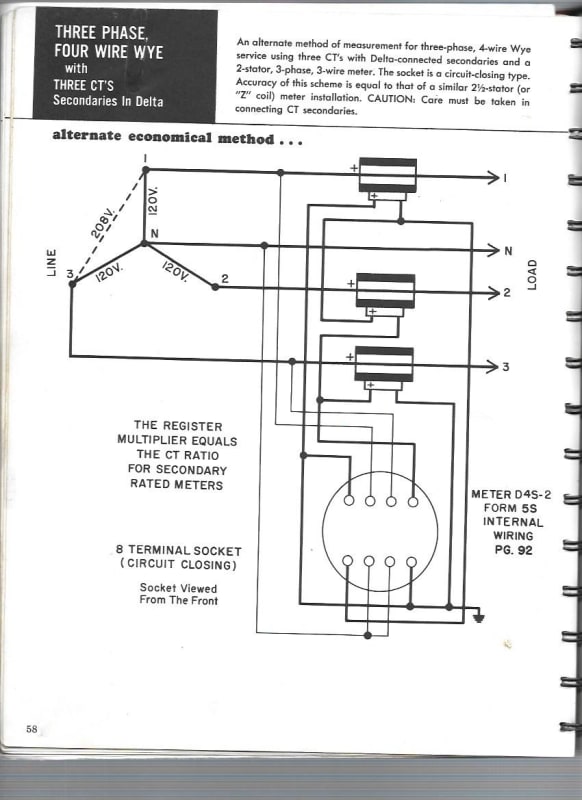I am replacing a older Form 45S (Elite) meter with a Form 5S (SEL734/5) type meter in a 69kV substation using SEL's recommended Form 5 wiring method.
The application is measuring power on a wye-grounded side of transformer. The meter has two (2) dedicated CTs. There are three (3) PTs (wye-connected primary). The PT secondary circuit is shared with relays (wye-grounded for relays). The relays have their own dedicated sets of three (3) CTs.
My questions are:
Can someone direct me to any representative white papers, or ‘meter man’s bible’ documents that show vector diagrams and wiring sketches for this type of modified Form 5 application. (Note: I cannot 'wrap' CT from other phase).
Setting aside the shared PT circuit at first -
With the PT secondary circuit wired directly to a Form 5 configuration (open delta - with un-metered phase at corner & grounded), will this work (Blondell's Theorem is satisfied)? My concern is that the wye-grounded system could have unbalanced load returning through the neutral.
Shared PT circuit and the need for Aux PTs -
If PT secondary circuit is shared and wired directly to the SEL meter (open delta - with un-metered phase at corner & grounded) does this negatively affect relay and its use of the PT circuit (wye-grounded for relays)?
Or, are two (2) 1:1 Aux PTs for the meter necessary? This would allow for grounding of un-metered phase(now isolated) facing the meter without affecting the relay PT circuit, correct?
With Form 5 application is grounding of the un-metered phase necessary with or without Aux PTs? If not grounded, would Form 5 wiring still negatively impact relays?
If you have dedicated PT secondary wiring for just metering, can you forgo Aux PTs? Or, are they still need for some sort of phase compensation? Is the phase compensation needed for relative consistency/comparison to what the relays are seeing or, does it also affect the power calculations in the meter (SEL claims the Aux PTs and grounding of un-metered/corner phase is not needed)?
The application is measuring power on a wye-grounded side of transformer. The meter has two (2) dedicated CTs. There are three (3) PTs (wye-connected primary). The PT secondary circuit is shared with relays (wye-grounded for relays). The relays have their own dedicated sets of three (3) CTs.
My questions are:
Can someone direct me to any representative white papers, or ‘meter man’s bible’ documents that show vector diagrams and wiring sketches for this type of modified Form 5 application. (Note: I cannot 'wrap' CT from other phase).
Setting aside the shared PT circuit at first -
With the PT secondary circuit wired directly to a Form 5 configuration (open delta - with un-metered phase at corner & grounded), will this work (Blondell's Theorem is satisfied)? My concern is that the wye-grounded system could have unbalanced load returning through the neutral.
Shared PT circuit and the need for Aux PTs -
If PT secondary circuit is shared and wired directly to the SEL meter (open delta - with un-metered phase at corner & grounded) does this negatively affect relay and its use of the PT circuit (wye-grounded for relays)?
Or, are two (2) 1:1 Aux PTs for the meter necessary? This would allow for grounding of un-metered phase(now isolated) facing the meter without affecting the relay PT circuit, correct?
With Form 5 application is grounding of the un-metered phase necessary with or without Aux PTs? If not grounded, would Form 5 wiring still negatively impact relays?
If you have dedicated PT secondary wiring for just metering, can you forgo Aux PTs? Or, are they still need for some sort of phase compensation? Is the phase compensation needed for relative consistency/comparison to what the relays are seeing or, does it also affect the power calculations in the meter (SEL claims the Aux PTs and grounding of un-metered/corner phase is not needed)?

